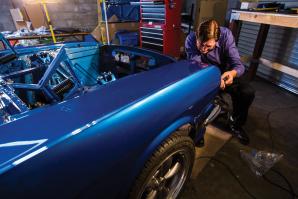If Rick Wylie were cast in a Chevy commercial, the director might pair him with a rugged pickup truck. It makes sense; Wylie worked his way up from sheet-metal apprentice to president of a construction company. In the real world, however, Wylie drives a Volt, pearl white with black trim.
Wylie is proof that hybrids are not just for tree-huggers and yoga moms. And that’s exactly the message manufacturers need to send if hybrid sales are ever going to compete with traditional vehicles, says Jesse Toprak, vice president of market intelligence for TrueCar.com in Santa Monica.
“You can sell to Sierra Club members, no problem. Unfortunately, there is a limited number of them,” Toprak says.
Now, the mass market may finally be paying attention.
Overall car sales in the first quarter of this year were up 13 percent from the same period in 2011, while hybrid sales shot up 37 percent. Plug-in sales were up more than 300 percent. Coupled together, these energy-efficient alternatives still only make up about 3 percent of total vehicle sales. But more people are buying them than ever before.
Hybrid buyers can’t be categorized, says John Roth, Internet director at Roseville Toyota. “I really can’t say that it is over 40, under 40, families. It really is everybody. Some are bringing in prior-year Priuses. Some are bringing in trucks, sport utility vehicles.”
Hybrids aren’t economy cars and never were. The Toyota Prius, which accounted for more than half of all hybrid sales in California in the first quarter, costs more than a Camry. The plug-in Prius is in the same price range as an Avalon or a 4Runner: $32,000 to $40,000.
Early adopters were willing to pay the price to save the environment and grab some of the cool factor, Toprak says. But mass-market buyers need more confidence that the investment will pencil out in the long run.
Pike Research in Boulder, Colo., estimates that over the course of 120,000 miles, a $39,000 plug-in hybrid costs about the same as a traditional, $22,400, 4-cylinder car with a 2.4-liter engine.
It pencils great for Wylie, who produces solar energy at home, eliminating the cost of running his car around. It works for his business image as well. His company, Beutler Corp., specializes in heating and air conditioning with an emphasis on energy efficiency.
The only warning Wylie offers potential Volt buyers is that running the heating or air conditioning on high can drain the battery quickly.
Charging may not cost Wylie any out-of-pocket money, but it does take time. On the 220-volt line he uses at home, a full charge takes about four hours, he says. At work, he uses the 110-volt charger that comes with the car. That takes about 10 hours.
Chevrolet halted Volt production for about five weeks in March and April for a bit of retooling, making it tougher for some dealers to get the newest models. But Kevin Bowers, general manager at Performance Chevrolet in Sacramento, has sold every one he’s been able to get on the lot.
“A lot of the customers that are trading in are trading in big V-8 units,” he says.
These days, a lot of different automakers have hybrids in their lineups, even Cadillac and Porsche. A new entry as of last year, the Fisker Karma, is priced even higher.
“It is a $110,000 car, so it appeals to the very upper end of the market. But when you compare what you are getting for your money, it is quite a beautiful automobile,” says John Driebe, who sells them along with Nissan, Infiniti and Mazda in Elk Grove.
At that price, a lower gasoline bill isn’t likely to figure into the car’s value.
Recommended For You

Classics Gone Green
A new take on an old favorite
Gary Morton has a dream and a car. If his dream comes true, like those of Henry Ford and Karl Benz before him, Morton will turn his prototype into a car company.
But Morton is not looking to build a big assembly plant or an extensive dealer network. His production will be limited to just one model that will offer baby boomers the nostalgia of the muscle cars they drove in their youth alongside their modern commitment to a pollution-free environment.

It’s Impolite to Squat
EV owners find it increasingly difficult to plug in
Long before it was widely accepted, Sacramento attorney Mike Polis bought his first electric vehicle. He got started with a Toyota Prius, later upgraded to a Nissan Leaf and now drives a white Chevy Volt. On average, he saves more than $3,500 a year over his gas-powered counterparts, he can use the HOV lane as a single occupant and he charges his car for free at work.


